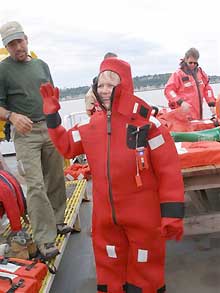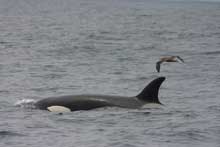About the Program

Who May Apply
Types of Cruises
Time Commitment
Life at Sea
Costs
Obligations as a TAS
Benefits for All
Who May Apply
To be considered for becoming a NOAA Teacher at Sea, you must:- Be currently employed, full-time, as:
- a K-12 teacher or administrator
- a community college, college, or university teacher
- a museum or aquarium educator
- an adult education teacher
- We regret that we cannot accept applications from part-time, substitute, or pre-service teachers or teaching assistants.
- Provide evidence of good health as determined by a completed
medical history and have passed a TB test within 12 months of your
sailing date. Applications received without a completed heath questionnaire will not be considered.
- IMPORTANT: Some cruises, especially fisheries cruises, require high-intensity work that demands physical adeptness and endurance. Work shifts on some ships may be 4 hours on/4 hours off, 6 hours on/6 hours off, or 12 hours on/ 12 hours off. You may also be required to work a night shift.
- Have flexibility and the ability to cope with the uncertain (see "Life at Sea")
- Have a unique ability to communicate complicated information to students, with a special interest in NOAA-related science.
- Have a principal/supervisor/department head who is supportive of your endeavor.
- Have superior English language ability (dual language ability is a plus).
- Be comfortable with travel and have no aversions to traveling by airplane or ship.
- Be computer literate.
- You are not required to have a passport to apply, but your options for cruises may be limited if you are selected because NOAA ships sometimes travel into international waters, for which a passport is required.
(top)
Types of Cruises
Participants are assigned a cruise aboard one of NOAA's 19 ships (or a chartered partner ship). NOAA conducts three main types of cruises. Fisheries research ships perform biological and physical science studies in support of fisheries research. Oceanographic and coastal research ships perform physical science studies in support of physical oceanography, atmospheric studies, and bathymetric mapping. Hydrographic survey ships scan the coastal sea floor with side-scan sonar and sophisticated bottom sounding systems to locate submerged obstructions and navigational hazards for the creation or update of the nation's nautical charts.
(top)

Time Commitment
Participants can expect to be at sea anywhere from one week to one month, with the average cruise lasting 12-14 days. Most of our participants try to sail on cruises offered during the summer vacation, but cruises take place throughout most of the year on a space-available basis.
Because of Homeland Security reasons, specific NOAA ship schedules are no longer made available to the public. Therefore, we ask applicants to list all the dates they will be available to sail on their application so that we can then match participants' requests to a ship's schedule. The public may view NOAA's fleet allocation plan by going to http://www.omao.noaa.gov/shipallocation.html
(top)Life at Sea
One aspect that NOAA’s Teacher at Sea program finds crucial to emphasize is that life at sea can be very unpredictable and flexibility and the ability to cope with the uncertain is crucial to the character of those who go to sea. Applicants should keep in mind the necessity for flexibility regarding ship departures and arrivals, ship working shifts, and the level of work intensity on some ships. As the unforeseen sometimes occurs, ship departure and arrival dates are never guaranteed. In fact, sailing can never be guaranteed. In addition, work shifts on some ships may be 4 hours on/4 hours off, 6 hours on/6 hours off, or 12 hours on/12 hours off. You may also be required to work a night shift. Finally, some cruises, especially fisheries cruises, require high-intensity work that demands physical adeptness and endurance.
General Shipboard Policy Information contains useful information about ship policies and procedures. Some individual ship's pages also have further information for visiting teachers about life aboard a ship. One site, supported by the Northeast Fisheries Science Center, has a very useful manual for cruise volunteers and first-time sailors about life at sea. Please note that NOAA Teachers at Sea are not permitted under any circumstances to SCUBA dive even if he or she has been SCUBA certified. If you are interested in information about SCUBA diving, please visit the NOAA Dive Center site.
(top)
Costs
All necessary travel costs are paid for by NOAA's Teacher at Sea Program. While airfare is paid for up front by the government, all other costs are reimbursed, including transportation costs, hotel costs, and per diem allowance.
(top)
Obligations as a Teacher at Sea
As a NOAA Teacher at Sea, you must be willing to fulfill several program requirements prior to, during, and after your cruise. Major oblilgations require participants to:
- Submit 2 to 3 logs per week with digital photographs while at sea or upon return.
- Submit receipts and travel voucher for reimbursement.
- Submit a post-cruise survey.
- Submit one lesson plan that addresses the science and research that was being conducted on the mission.
- Submit one lesson plan, activity, or similar document (e.g. brochure, flyer) that addresses ocean careers.
- Create and administer a test before and after teaching your lesson plan that measures students’ knowledge of the lesson’s subject matter as appropriate to grade level.
- Submit one copy of the test and its overall results, both pre- and post-lesson.
- Submit an article for publication OR conduct a presentation about your mission at an educators' conference or for colleagues.
Once selected, participants will be assigned to a vessel on a space-available basis only. They will work with the scientific team under the direction of the Chief Scientist and the ship's Commanding Officer. Independent scientific projects must be coordinated with the Chief Scientist.
(top)
Benefits for All
The benefits of NOAA's Teacher at Sea program are substantial for several stakeholders. To begin with, scientists, NOAA Corps officers, and crew gain motivated volunteers to help carry out their projects, and all onboard enjoy hosting someone who is enthusiastic and eager to learn about each aspect of the cruise.
Another crucial benefit offered by the Teacher at Sea program to NOAA and the nation is students' increased exposure to knowledge of marine careers. By talking about their experiences and sharing photos or video taken during a cruise, teachers can encourage their students to consider potential marine careers with NOAA or other science-based organizations.
And perhaps most importantly, the program serves NOAA's mission by promoting among teachers and their students a greater awareness of the need to understand and protect the world's oceans and their resources.
The feedback from teachers who have participated in the program is overwhelmingly positive. Teachers underscore the fact that not only do they themselves benefit from what they learn on their cruises, but so do their students, communities, and the environment in general.
Indeed, these benefits may best be described by Melissa Fye, an elementary school teacher from Virginia: " I'm taking back to my classroom a wealth of resources like maps, charts, a binder of lessons, and many photographs and digital movies to weave into science lessons. But more importantly than those things, I will be bringing back to the classroom real-life enthusiasm for the application of science in the real world. I have experienced first-hand, biological ecosystems, weather instruments and measurements, and map making, in a real-life context. I want my students to know that life is not a collection of things, but a collection of experiences. I hope this trip encourages them to explore opportunities as they arise in their own lives. As a teacher, my underlying goal is to teach my students that learning should be a life long adventure! And isn't that what this trip is really all about?"
(top)
Site Index | About the Site | Privacy Policy
